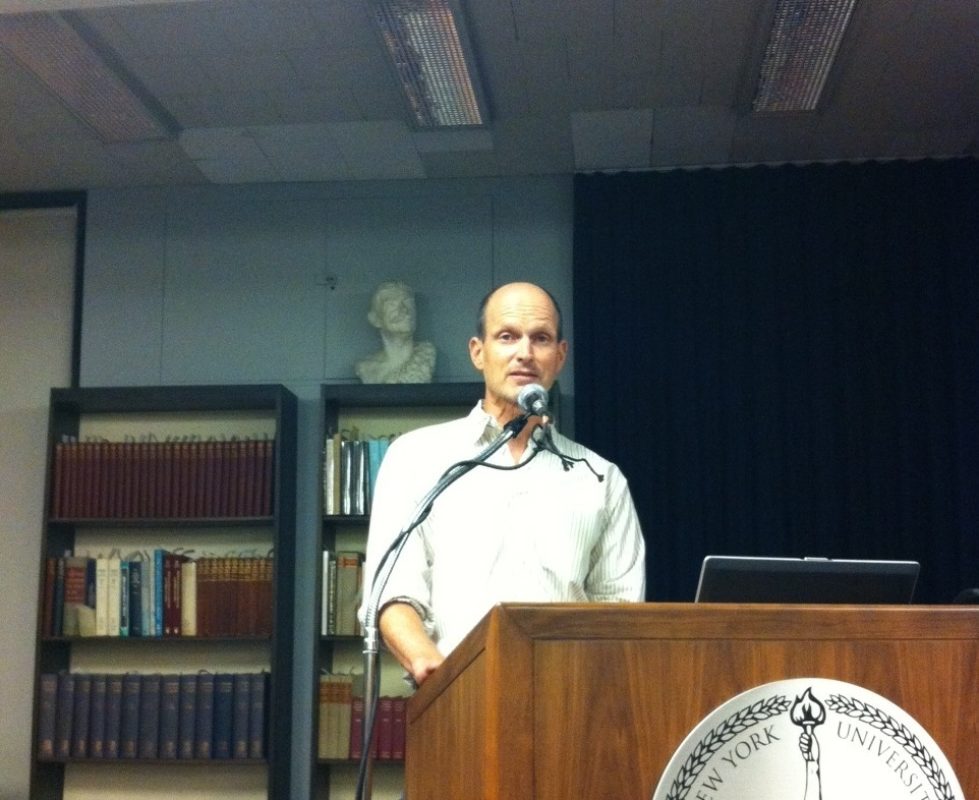On September 24,2012 panelists Gregg Bordowitz Joy Episalla, Loring McAlpin, and Harvey Weiss with moderator Barbara Hunt Mclanahan, gathered for Frank Moore: Together in Art and Activism. Presented by Visual AIDS and Grey Art Gallery at NYU’s Fales Library, the panel discussion was an opportunity to explore the life of Moore, while diving into relationships between art and activism. Each panelist took a personal but diverse approach.
Loring McAlpin
Artist Loring McAlpin, in his discussion of Frank Moore, began by remembering his attraction to Moore and how that fanned out into appreciating and learning how Moore saw the world, "I felt an instant liking of him, not so much because he was gay, or involved with AIDS politics, or an artist, although all of these things I considered to be a part of me and were what I wanted to identify with. Or because he was such a handsome guy. It’s hard not to swoon looking at early photos of Frank.
What stood out even more clearly for me, and made me want to know him, was his awareness of the natural world. Frank could, and would, point out what plant you were standing next to, whether it was an American lotus, a Dutchman’s pipe, or a slum pine (botanical name, Ailanthus) growing out of a crack in the pavement…More than just identify something, he could, and often would, add how that plant affected a whole ecosystem that ended up including you. In his conversations, as well as in his paintings, Frank sketched layers of experience and meaning, fusing the sensual with the intellectual, creating a sense of place, but also places with meaning. Part close reading based on his act of seeing, but part essay as well. Frank drew connections, sketching a humanist vision of how the world was, and what it could be, even as he pointed to that which was hardest to look at – greed, environmental degradation, homophobia, the voracious maw of industry, and death. Even in the detritus of an abandoned lot, in the cold expanse of a hospital bed or the scorched earth of an experimental drug trial, he could find something beautiful - a hint of redemption even within our biggest missteps"
It was through this recollection that McAlpin recovers a point of contact with Moore, "Only later did I come to realize that we had both grown up wandering through the woods of the Adirondacks, carving designs in wood ears, catching minnows, butterflies, and frogs, looking for mayfly larva under rocks in its streams. That was a very powerful connection, and we continued to share this as adults, both as memory and as activity."
Towards the end, McAlpin touches on Moore’s legacy, "In so many ways, Frank mentored myself and many others along an artistic path. Whether quietly drawing others’ attention to your work, behind your back, discussing a production detail, or inviting you into his studio and process. This is something not clearly documented, but I know of many who received both subtle and sustained attention. It may be difficult to quantify these effects, but they are as important and as lasting as anything else that Frank achieved, and that attention continues bearing fruit today."
Loring McAlpin divides his time between art projects, documentary film and philanthropy. As an installation artist, he has worked wth the art collective Gran Fury and GANG as well as individual projects in New York and internationally. Film work includes Herman's House, 2012 (Producer), The Delta 1997 (Assoc. Producer); and currently, he's directing a doc on land reform in South Africa.
